Woodbridge, NJ Pollen and Allergy Report for Summer 2023
Pollen Allergy Trends in Woodbridge, NJ
When is pollen lowest in Woodbridge, NJ?

February
Lowest month total PPM
Avg. PPM
When is pollen highest in Woodbridge, NJ?

April
Highest month total PPM
Avg. PPM
How does pollen in Woodbridge, NJ compare to New Jersey?
Woodbridge has a higher average PPM than the state of New Jersey.
Woodbridge yearly avg PPM:
New Jersey yearly avg PPM:
How does pollen in Woodbridge, NJ compare to the USA?
Woodbridge has a higher average PPM than the USA.
Woodbridge yearly avg PPM:
USA yearly avg PPM:
Is pollen worse this year in Woodbridge, NJ?
Spring 2023 was worse than spring 2022.
Spring 2023 PPM:
Spring 2022 PPM:
Average PPM in Woodbridge, NJ
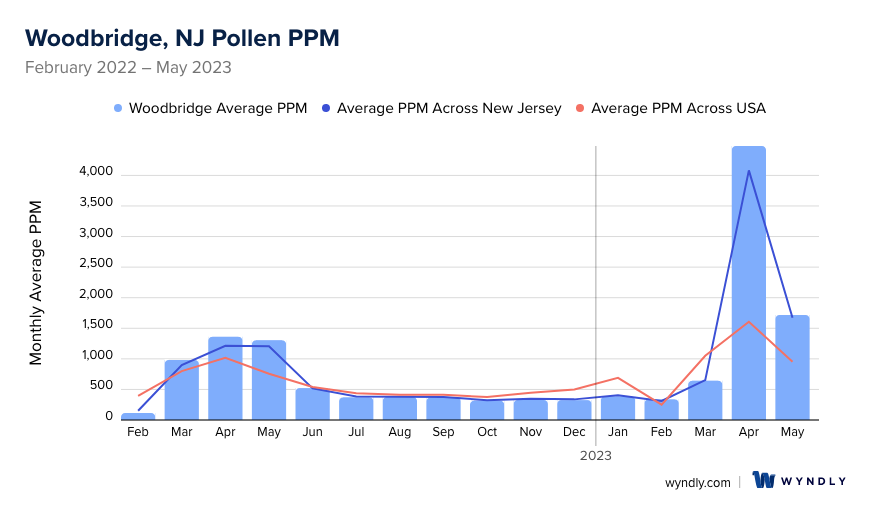
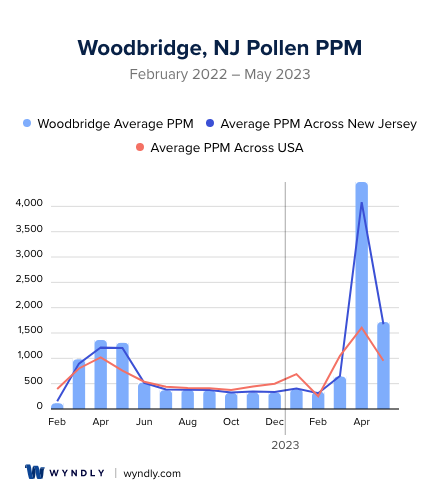
Woodbridge, NJ Pollen and Allergy Breakdown by Month
Grass
When is grass pollen highest in Woodbridge, NJ?
April has the highest grass pollen in Woodbridge, NJ with an average PPM of
When is grass pollen lowest in Woodbridge, NJ?
December has the lowest grass pollen in Woodbridge, NJ with an average PPM of
Tree
When is tree pollen highest in Woodbridge, NJ?
April has the highest tree pollen in Woodbridge, NJ with an average PPM of
When is tree pollen lowest in Woodbridge, NJ?
January has the lowest tree pollen in Woodbridge, NJ with an average PPM of
Weed
When is weed pollen highest in Woodbridge, NJ?
April has the highest weed pollen in Woodbridge, NJ with an average PPM of
When is weed pollen lowest in Woodbridge, NJ?
February has the lowest weed pollen in Woodbridge, NJ with an average PPM of
Woodbridge, NJ Pollen Monthly Breakdown by Pollen Type
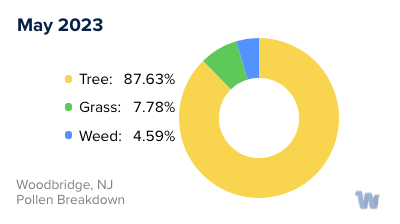
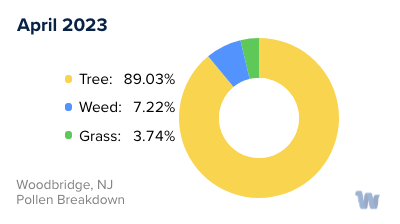
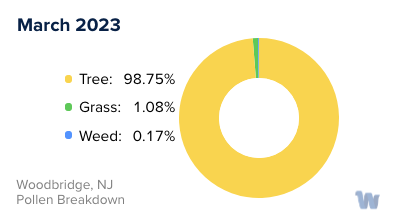
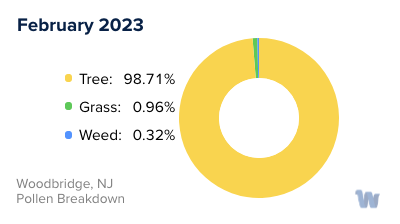
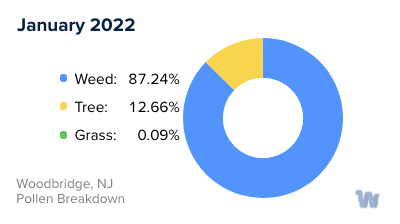
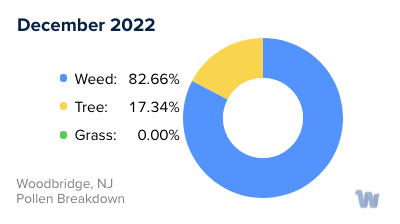
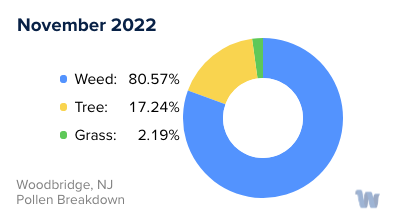
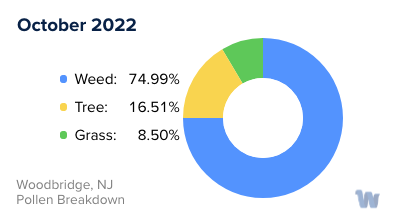
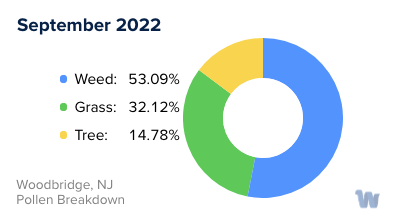
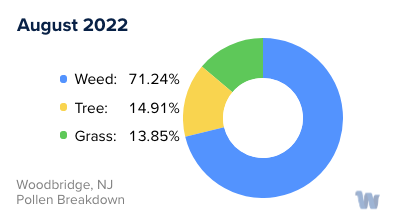
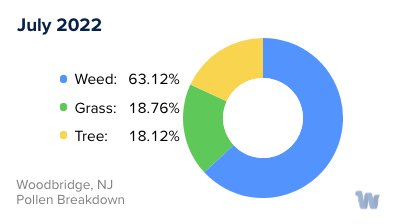
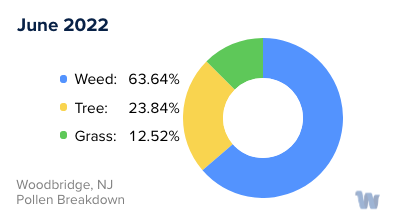
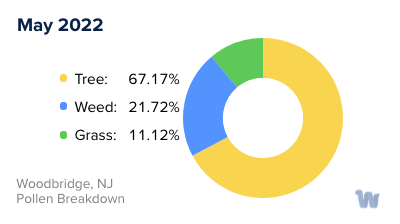
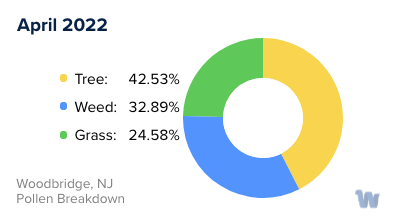
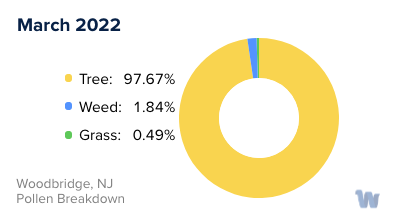
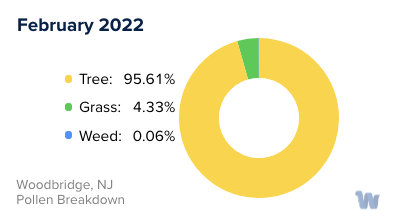
Pollen and Hay Fever in Woodbridge, NJ
In the picturesque town of Woodbridge, New Jersey, the change of seasons brings an array of vibrant colors and fragrances. However, for some residents, this natural splendor comes with a less welcome guest: pollen allergies, often referred to as hay fever.
Pollen allergies are the immune system's response to tiny grains released by plants for fertilization. In Woodbridge, the primary culprits are trees, grasses, and weeds. Each of these produces pollen at different times of the year, leading to varying allergy seasons.
In the spring, tree pollen takes center stage. The town’s abundant oak, maple, and pine trees burst into bloom and release copious amounts of pollen into the air. The weather during this season is characterized by mild temperatures and breezy conditions, which facilitate the dispersal of pollen.
As the calendar turns to summer, grass pollen begins to dominate. The lush green lawns and parks of Woodbridge are primarily composed of Bermuda and Kentucky bluegrass. These grasses are in full bloom during the warm summer months, and their pollen can be particularly irritating for those with sensitivities.
Come fall, weed pollen, especially from ragweed, emerges as the main offender. Ragweed thrives in the temperate climate of Woodbridge and can produce a staggering amount of pollen. Moreover, the mild fall temperatures and occasional rain help keep the pollen airborne for extended periods.
It's important to note that while the bulk of pollen production happens in spring, summer, and fall, indoor plants can also release pollen during the winter, though on a much smaller scale.
For the residents of Woodbridge, staying informed about the types of pollen and the seasons in which they are prevalent can be instrumental in managing their daily activities and maintaining a high quality of life during these naturally vibrant seasons.

